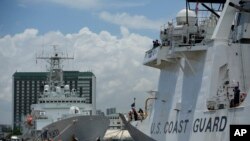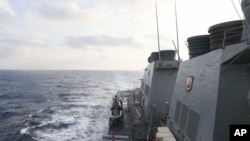On June 6, China’s Foreign Ministry claimed that Beijing “respects the right of navigation and overflight” guaranteed under international law, “but firmly opposes any action that undermines China’s sovereignty and security.”
The ministry’s statement came in response to U.S. Navy reports about the “unsafe” conduct of its Chinese counterparts.
“This is not about 'freedom of navigation', but rather hegemony of navigation. This is the root cause of security risks at sea and in the air,” it tweeted.
That is false.
The United States exercises the right of innocent passage in international waters.
It is China’s attempts to exert hegemony — predominance of one state over others — over the South China Sea that are putting the security of Beijing’s neighbors at risk.
On June 3, a U.S. destroyer and Canadian frigate transited the Taiwan Strait, conducting what the U.S. called a “freedom of navigation” operation.
During that exercise, the U.S. Navy said, a Chinese vessel conducted an “unsafe” maneuver by cutting in front of the U.S. ship, forcing it to slow down.
On May 26, the U.S. military accused a Chinese fighter jet of performing “an unnecessarily aggressive maneuver” while intercepting a U.S. military aircraft over international waters.
China is attempting to exert dominion over roughly 90% of the South China Sea, demarcated by its so-called nine-dash line.
But The Hague has rebuked China’s sweeping claims to the sea, as they have no basis in international maritime law.
Under the United Nations Convention on the Law of the Sea (UNCLOS), China is considered a coastal state. A coastal state’s territorial waters extend 12 nautical miles from its coast’s low water mark.
China claims that Taiwan is also Chinese territory, and it views the 12 nautical mile stretch from Taiwan’s coast as Chinese territorial waters.
Taiwan views itself as independent.
Regardless of Taiwan’s status, the U.S. contends that a stretch of sea in the Taiwan Strait is international waters, and thus open to innocent passage under Article 19 of UNCLOS.
That’s because the Taiwan Strait is 100 miles wide at its narrowest point, which would leave a corridor beyond the territorial waters of China and Taiwan.
China argues that U.S. ships sailing “all the way to China's periphery” constitutes a “muscle-flexing provocation.”
But the evidence suggests that China’s neighbors are worried about Beijing’s actions in the region.
Take the Philippines, which initiated a claim against China at the Permanent Court of Arbitration in The Hague.
The international court’s ruling in that case reaffirmed the right of states to operate within their 200-mile exclusive economic zone (EEZ). China has disregarded that ruling.
From June 1-7, the coast guards of the U.S., Japan and the Philippines held their first-ever joint maritime exercise in the South China Sea. That followed the 38th Balikatan joint military exercise between Philippine and U.S. forces — the largest of its kind in three decades.
In February, the U.S. and Philippines announced an Enhanced Defense Cooperation Agreement granting the U.S. access to military installations in the Philippines.
The moves came in response to China’s increased militarization of the South China Sea and actions that the Philippines considered hostile, despite former President Rodrigo Duterte’s attempts at closer ties with China.
The Philippines has lodged hundreds of diplomatic complaints against what it calls China’s “illegal” actions in the maritime region.
In February, the Philippines accused a Chinese coast guard ship of deploying a military-grade laser against a Philippine coast guard ship and of moving dangerously close to the vessel to block it from approaching the Second Thomas Shoal, a submerged reef in the contested Spratly Islands.
This is not the first time the Philippines has accused Chinese coast guard ships of conducting dangerous maneuvers close to Philippine coast guard vessels.
In November 2021, China’s coast guard blocked and used water cannons against Philippine resupply ships headed to the Second Thomas Shoal.
The Philippines has repeatedly accused China of harassing Philippine fishing boats operating within the Philippines' EEZ. It has also accused Beijing of swarming waters in the Philippines’ EEZ with armed Chinese fishing vessels.
The Philippines is not alone.
China has more than once sunk Vietnamese fishing boats near the Paracel Islands. It has also reportedly threatened to use force to halt Vietnamese drilling projects that fall within Beijing’s so-called nine-dash line.
In May, Vietnam demanded that China remove its coast guard and fishing vessels “out of Vietnam's waters” within Hanoi’s EEZ.
Chinese ships have also reportedly engaged in standoffs with Malaysian ships operating within Malaysia’s EEZ, which the U.S. called “bullying behavior.”
In December 2022, Vietnam and Indonesia worked out an agreement on the boundaries of their EEZs in the southern portion of the South China Sea. The ASEAN Briefing news service framed the agreement as a potential step in forming “a united front against the Chinese claims.”
In response, China dispatched its largest coast guard vessels to patrol Indonesia’s Natuna Islands to “send a signal,” regional experts told the South China Morning Post.
Japan also beefed up its defense posture in response to China’s increased militarization of the region and efforts to dominate the East and South China seas, wrote Madoka Fukuda, a law and global politics professor at Hosey University, Japan, in a recent analysis.







